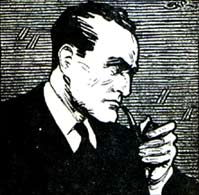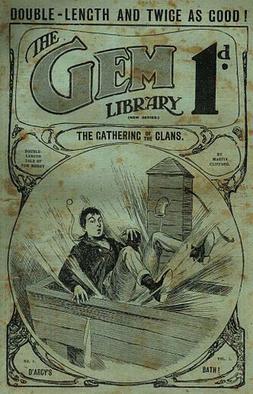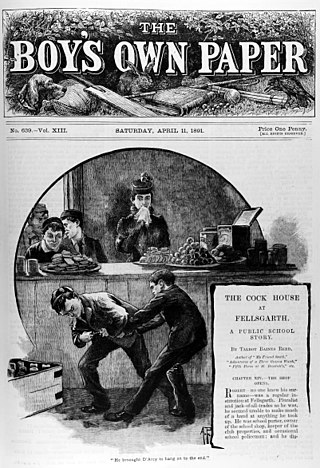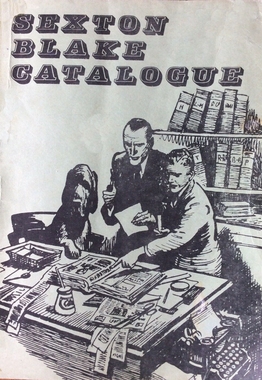
Sexton Blake is a fictional character, a detective who has been featured in many British comic strips, novels and dramatic productions since 1893. Sexton Blake adventures were featured in a wide variety of British and international publications from 1893 to 1978, comprising more than 4,000 stories by some 200 different authors. Blake was also the hero of numerous silent and sound films, radio serials, and a 1960s ITV television series.

Penny dreadfuls were cheap popular serial literature produced during the 19th century in the United Kingdom. The pejorative term is roughly interchangeable with penny horrible, penny awful, and penny blood. The term typically referred to a story published in weekly parts of 8 to 16 pages, each costing one penny. The subject matter of these stories was typically sensational, focusing on the exploits of detectives, criminals, or supernatural entities. First published in the 1830s, penny dreadfuls featured characters such as Sweeney Todd, Dick Turpin, Varney the Vampire, and Spring-heeled Jack.
The Amalgamated Press (AP) was a British newspaper and magazine publishing company founded by journalist and entrepreneur Alfred Harmsworth (1865–1922) in 1901, gathering his many publishing ventures together under one banner. At one point the largest publishing company in the world, AP employed writers such as Arthur Mee, John Alexander Hammerton, Edwy Searles Brooks, and Charles Hamilton. Its subsidiary, the Educational Book Company, published The Harmsworth Self-Educator, The Children's Encyclopædia, and Harmsworth's Universal Encyclopaedia. The company's newspapers included the Daily Mail, the Daily Mirror, The Evening News, The Observer, and The Times. At its height, AP published over 70 magazines and operated three large printing works and paper mills in South London.

The Magnet was a British weekly boys' story paper published by Amalgamated Press. It ran from 1908 to 1940, publishing a total of 1,683 issues.

The Gem (1907–1939) was a story paper published in Great Britain by Amalgamated Press in the early 20th century, predominantly featuring the activities of boys at the fictional school St. Jim's. These stories were all written using the pen-name of "Martin Clifford," the majority by Charles Hamilton. Many issues also included a shorter serial story ; these parts of the paper were not written by Charles Hamilton.

The Comet was a weekly British comics periodical published by J.B. Allen and later Amalgamated Press and Fleetway Publications from 20 September 1946 to 17 October 1959. Initially a children's newspaper, The Comet was transformed into a boys' adventure comic in May 1949 by editor Edward Holmes when J.B. Allen were purchased by Amalgamated Press. Also known as Comet Comic, The Comet Adventure Weekly, Comet Weekly and simply Comet as various points the title continued until October 1959, reaching 580 issues before being merged with another AP boys' comic, Tiger.
Ernest Sackville Turner was an English freelance journalist and writer who wrote 20 published books, including Boys Will Be Boys, The Phoney War on the Home Front, and What The Butler Saw, and contributing to the Times Literary Supplement, London Review of Books, and regularly to the English satirical weekly magazine Punch.

The Boys' Herald was a boy's story paper published by Amalgamated Press in England from 1903. It was a companion paper to The Boys' Friend and The Boys' Realm. It mostly ran adventure stories and sold for 1d. It ceased publication in 1913.
Elizabeth Gertrude Bunter, better known as Bessie Bunter, is a fictional character created by Charles Hamilton, who also created her more famous brother Billy Bunter.

The Union Jack was a British story paper for children of the late 19th and early 20th centuries. There were two story papers called Union Jack. The first appeared in the 1880s but was only very short-lived. The name was then used by Alfred Harmsworth in 1894 for a new halfpenny story paper intended as a companion to the successful Halfpenny Marvel.

Magazines intended for boys fall into one of three classifications. These are comics which tell the story by means of strip cartoons; story papers which have several short stories; and pulp magazines which have a single, but complete, novella in them. The latter were not for the younger child and were often detective or western in content and were generally greater in cost. Several titles were published monthly whereas the other two categories were more frequent.

Knockout was a weekly British comics periodical published by Amalgamated Press and later Fleetway Publications and IPC Magazines from 4 March 1939 to 16 February 1963. A boys' adventure comic, the title ran for 1227 issues before being merged with Valiant.

Nelson Lee is a fictional detective who featured in the Amalgamated Press papers over a 40-year run. Created in 1894 by Maxwell Scott he appeared in various publications including The Halfpenny Marvel, Pluck, The Boys' Friend, Boys' Realm, The Boys' Herald and the Union Jack In 1915 he was given his own story-paper series, The Nelson Lee Library, which ran until 1933.

John William Staniforth was a British writer who wrote under the pen-names Stain Cortley, John Andrews and Maxwell Scott.

William Murray Graydon was an extremely prolific American writer who also wrote under the pen-names Alfred Armitage, William Murray, and Tom Olliver. He wrote adventure, historical fiction and Sexton Blake detective stories for boy's story papers.

Sexton Blake is a fictional detective who has been featured in many British comic strips, novels, and dramatic productions since 1893. He was featured in various British publications from 1893 to 1978 in a variety of formats: single-issue adventures, short stories, serials, and comic strips. In total, Blake appeared in more than 4,000 stories by over 200 different authors. During its golden age (1920s-1940s), Blake's adventures were widely read and translated into at least twenty different languages, including Swedish, Norwegian, Finnish, Dutch, Spanish, German, Portuguese, Italian, French, Arabic, Hindi, and Afrikaans.
Sexton Blake is a fictional detective who has been featured in many British comic strips, novels, and dramatic productions since 1893. He was featured in various British publications from 1893 to 1978 in a variety of formats: single-issue adventures, short stories, serials, and comic strips. In total, Blake appeared in more than 4,000 stories by over 200 different authors.
During its golden age (1920s-1940s), Blake's adventures were widely read and translated into at least twenty different languages, including Swedish, Norwegian, Finnish, Dutch, Spanish, German, Portuguese, Italian, French, Arabic, Hindi, and Afrikaans.
Sexton Blake is a fictional detective who has been featured in many British comic strips, novels, and dramatic productions since 1893. He was featured in various British publications from 1893 to 1978 in a variety of formats: single-issue adventures, short stories, serials, and comic strips. In total, Blake appeared in more than 4,000 stories by over 200 different authors.
Sexton Blake is a fictional detective who has been featured in many British comic strips, novels, and dramatic productions since 1893. He was featured in various British publications from 1893 to 1978 in a variety of formats: single-issue adventures, short stories, serials, and comic strips. In total, Blake appeared in more than 4,000 stories by over 200 different authors.

School Friend was the name of a pioneering story paper marketed exclusively to girls, published from 1919 to 1929. The name was later used by Amalgamated Press on a girls' comic in 1950.














